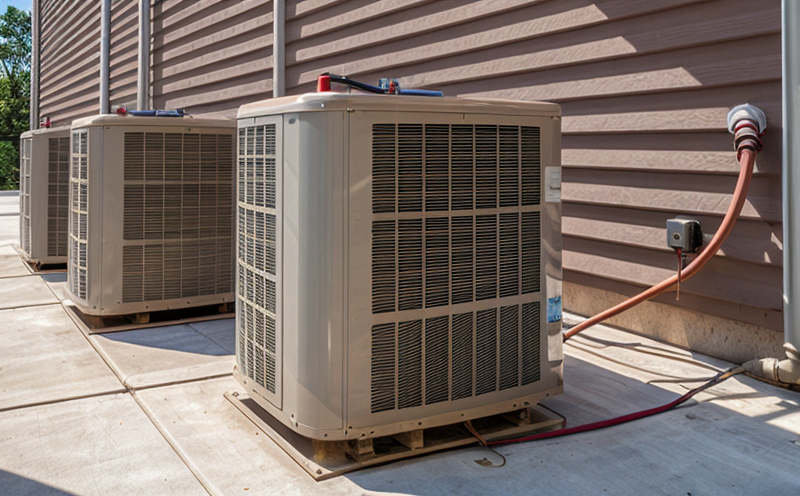ASHRAE 37M Airflow Measurement of Duct Systems
The ASHRAE 37M procedure is a critical standard used to determine the airflow through duct systems in buildings. This testing ensures that HVAC (Heating, Ventilation, and Air Conditioning) systems operate efficiently and meet design specifications. Proper measurement of airflow helps maintain indoor air quality, energy efficiency, and compliance with building codes.
Ducts form an integral part of any HVAC system. They transport conditioned air from the source to different areas within a building. To ensure these ducts perform optimally, it is essential to measure their airflow accurately. ASHRAE 37M provides guidelines for this measurement process using various methods and equipment.
The standard covers both new installations and existing systems. For newly installed ductwork, accurate airflow measurements allow project teams to verify that the system can deliver the promised performance levels. Existing systems benefit from these tests as they help identify potential issues or inefficiencies over time. Regular inspections based on ASHRAE 37M ensure sustained high-performance operation of HVAC equipment.
During testing, multiple points along the ducts are measured to get a comprehensive picture of airflow distribution. These measurements account for factors like pressure drops across various components and fan performance metrics. Understanding these variables enables better management strategies aimed at optimizing energy usage while maintaining comfort standards throughout all occupied spaces.
The accuracy achieved through ASHRAE 37M testing plays a pivotal role in several aspects:
- Ensuring compliance with building codes
- Achieving optimal HVAC system performance
- Maintaining indoor air quality
- Promoting sustainable practices by reducing energy consumption
- Identifying and addressing potential issues early on
To perform these tests accurately, specialized equipment is required. This includes anemometers, flow hoods, pitot tubes, manometers, differential pressure gauges, and other precision instruments designed to capture precise readings under various conditions.
Proper calibration of all measurement tools before each test run ensures consistent results across multiple assessments over time. Additionally, experienced technicians play a crucial role in ensuring accurate data collection during field operations.
The significance of ASHRAE 37M goes beyond just technical requirements; it also contributes significantly to overall building performance and occupant well-being. By adhering to this standard, organizations demonstrate their commitment to creating healthy indoor environments that contribute positively towards employee productivity and satisfaction.
Why It Matters
Accurate airflow measurement is paramount for HVAC systems in buildings because it directly impacts energy efficiency, occupant comfort, and overall building performance. When duct systems operate efficiently, less energy is wasted due to improper air distribution, leading to cost savings on utility bills.
Occupant comfort plays a crucial role in maintaining productivity levels within office spaces or classrooms. Properly balanced airflow ensures that everyone remains comfortable regardless of their location inside the structure. Poor airflow can lead to discomfort such as stuffiness, dryness, or even overheating zones which could negatively affect both physical health and work performance.
From an environmental perspective, ensuring HVAC systems function correctly contributes towards sustainability goals by reducing unnecessary energy consumption. With increasing focus on green building practices, accurate testing helps identify areas where improvements can be made to reduce carbon footprints associated with heating and cooling processes.
In addition to these benefits, regular compliance checks based on ASHRAE 37M help prevent costly repairs or replacements of faulty components early enough before they deteriorate further. This proactive approach saves money in the long run by avoiding unexpected breakdowns that could disrupt daily operations.
Applied Standards
The American Society of Heating, Refrigerating and Air-Conditioning Engineers (ASHRAE) publishes multiple standards related to HVAC systems including ASHRAE 37M. This particular standard focuses explicitly on airflow measurement techniques for ducts.
The latest version of ASHRAE 37M incorporates improvements based on feedback from industry professionals ensuring its relevance and applicability in real-world scenarios. Compliance with this standard is often required by local or national regulations governing construction projects involving HVAC installations.
Industry Applications
- New Construction Projects: Ensuring that newly installed HVAC ductwork meets design specifications before occupancy begins.
- Existing Building Retrofits: Identifying opportunities for improving system performance through targeted modifications or replacements of inefficient components.
- Compliance Audits: Providing objective evidence demonstrating adherence to relevant codes and standards during inspections conducted by regulatory bodies.
- R&D & Development: Continuously refining testing methodologies aimed at enhancing accuracy and reliability of results produced under different conditions.
- Quality Assurance Programs: Establishing benchmarks against which performance can be consistently evaluated over time, ensuring long-term stability in system operations.





